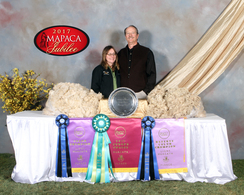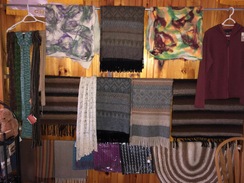Alpaca Fiber
Fiber is the ‘wool’ that the alpaca are famous for, and the ultimate commercial reason for raising alpaca. The fiber of alpaca is often compared to cashmere and should not be confused with typical sheep’s wool. One touch of an alpaca garment, and you will agree that there is almost nothing else as silky and soft to wear. They even make bikinis from alpaca. Try that with wool.
The alpaca’s fiber does not contain lanolin that needs to be chemically stripped from the fiber and therefore is able to go straight from the animal to the spinner with only a minimum of effort in cleaning. Many hand spinners are alpaca owners for this very reason. The commercial processing of alpaca fiber in the United States is still many years away. There are simply not enough American alpacas to supply the industry. In order for this to take place, there will have to be roughly 100,000 pounds of a particular color. With the average annual fiber production of approximately 8 pounds per alpaca per year, you can see that we need a few more animals to achieve commercial status.
In the meantime, fiber is marketed in one of several ways. The ‘do it yourself’ method is one way. Since the processing of the fiber can be accomplished by simply removing the vegetable matter and second cuts (short fibers), hand spinning your own fiber is commonly practiced. Many alpaca owners are those with just two or three alpaca they have for there own fiber needs. For those with more fiber than they can process or are not inclined to process their own, many sell the fiber to local spinners and weavers through guilds. This network of spinners and weavers often purchase fiber in various amounts.
Larger farms typically send their fiber to one of several Co-ops in North America. There are several and they handle the fiber in different ways. One gathers the fiber for all the members until they have enough to export the material to Peru. The fiber is commercially processed and garments are returned to the members in exchange for your contribution after being assessed for quality characteristics. You will not necessarily receive garments made from your fiber since the fiber has been pooled to achieve the necessary quantity.
There are also Co-op’s that have formed to process the fiber here in the United States. In some cases you can have garments made from your actual fiber and specify the garment to be made. There are also several independent processes in the U.S. that provide the same services. These are usually ‘for hire’ situations where you not only contribute the fiber, but then also pay to have the garment produced. The pricing typically works out to a wholesale type price so that margin can be generated during your retailing of the products.
There are many variations of the above as an outlet for the fiber and finding a symbiotic outlet for yours is the key until true commercial processing is applied in the U.S. Prices vary widely for the fiber based on the demand in your area. Our experience has ranged from giving the fiber away to local weavers as a means to introduce it to them, to selling it for $32 per pound. We then receive garments from the processors for our small retail store at the farm.
So what are we looking for in quality alpaca fiber? This is very important to the breeder and educating yourself in this regard cannot be over-emphasized. Eventually, when fiber is the dominant reason for alpaca ownership, you want to have highly desirable fiber. For now let’s just talk mainly about the Huacaya alpaca, although many of these same attributes apply to the Suri as well. You should observe for the following main characteristics:
- Density and uniformity of density • obviously the more dense the fiber per square inch, the higher the yield from the animal come shearing day. After seeing and feeling a few alpacas you will be able to tell the dense from the not so dense. The fleece will have a more closed, spongy feel to it. This feel is one of the characteristics of the overall ‘handle’ of the fleece. This density should also be uniform throughout the blanket of the fleece. The blanket is defined as the fleece from the shoulders to the rump and around the flanks to the belly.
- Fiber length • again, an obvious factor in the volume you get from an animal on shearing day. This is referred to as ‘staple length’ and longer is better.
- Fineness • another aspect of the overall handle of the fleece, where finer is better. The finer fiber is more suited for the more luxurious garment applications and therefore is generally more valuable.
- Crimp • this is a reference to the wavy appearance found in higher quality huacaya fiber. There is tight crimp, loose crimp, bold crimp, and the more you talk to folks, the more kinds of crimp you will hear about. Basically crimp is good. It gives the fiber an improved elastic quality that is natural in alpaca fiber. The fiber is resilient and has a memory that allows it resume its natural shape after being stretched. It also reflects density since the fiber is more compact than straighter fiber. Crimp is usually more prevalent in the lighter colored animals.
- Luster • this refers to the shine or brightness of the fiber. The more lustrous the better regardless of fiber color. The lighter colored animals are typically capable of more luster than darker animals.
- Coverage • this is reference to having good fiber coverage all over the alpaca’s body including the legs, chest, neck, and face. Although the fiber harvested from these areas is not valued is highly as the blanket, you want it to be as prevalent and high in quality as possible. On quick glance, it also gives you an indication of the overall fiber characteristics of the animal.
So this is easy right? Just go out and get yourself all the, long, dense, fine, crimpy, and lustrous animals with hair growing on their toes as you can find, and start yourself a farm. Well, there may be a little problem. Not many animals have all these characteristics, and when they do, they are costly number one, and hard to get the owner to turn loose of number two. But there is good news. Breeding can readily influence alpaca fiber quality.
Wednesday, December 30, 2020









